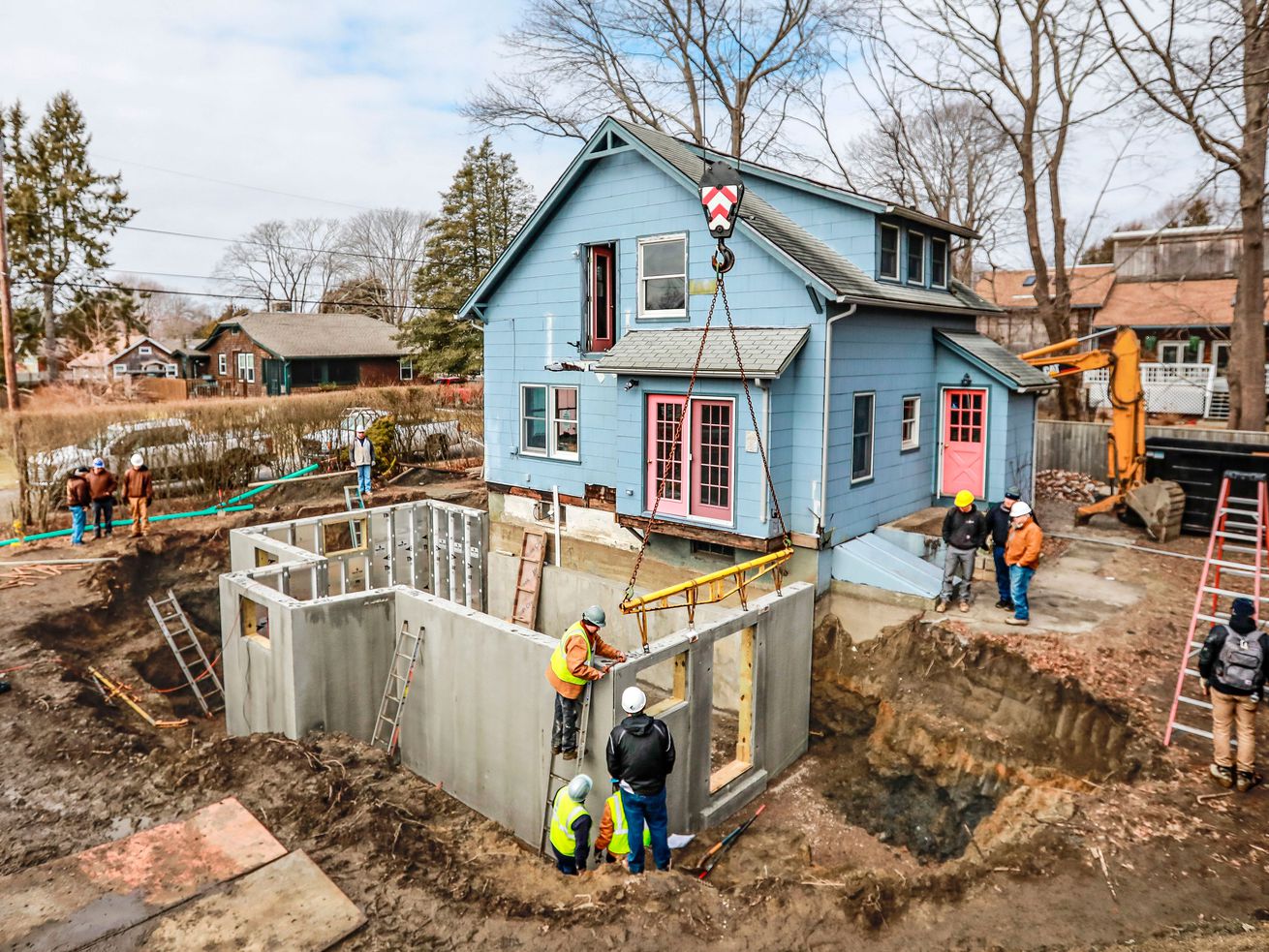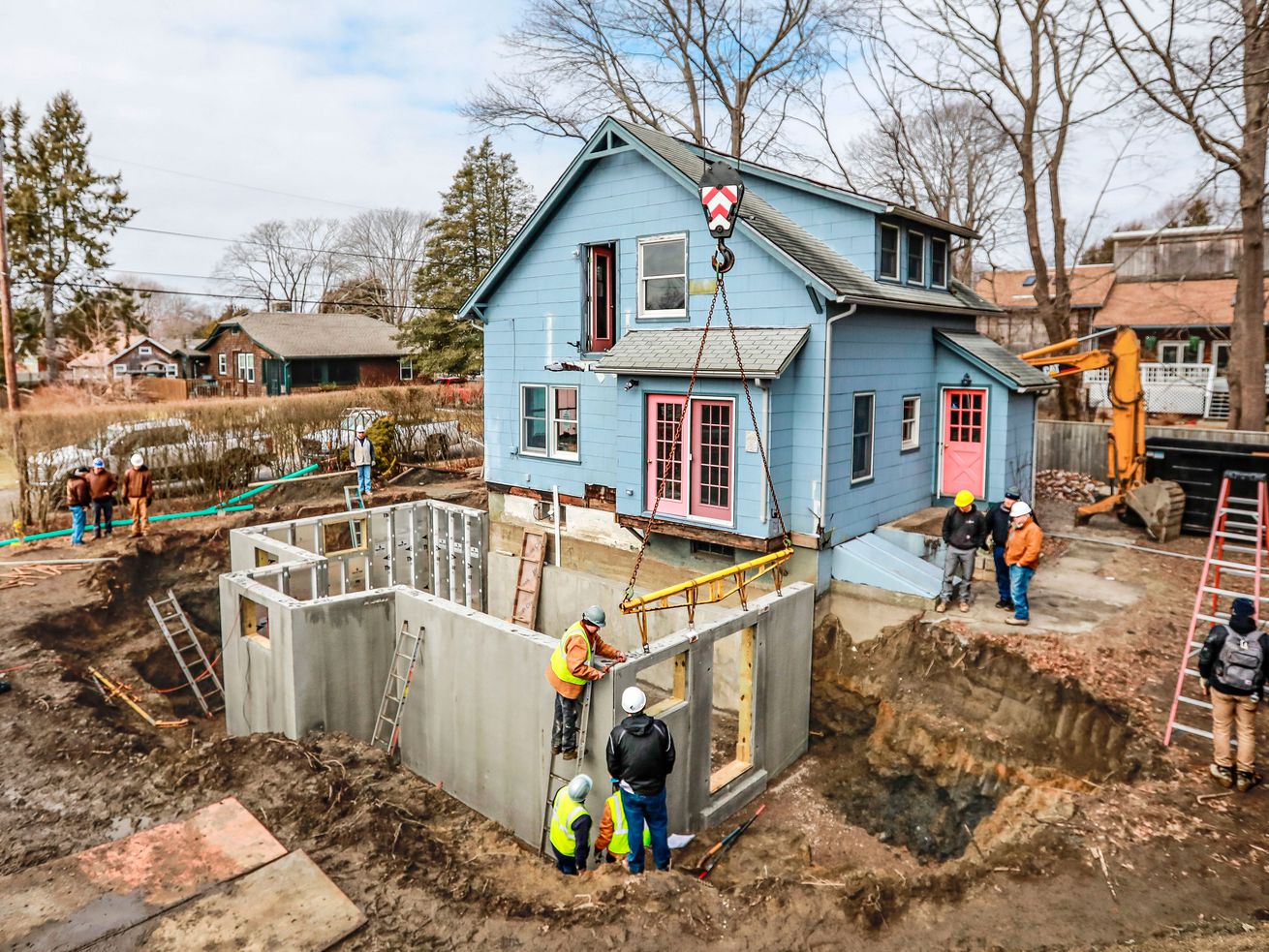House Foundations: Types and Common Problems

>

Carl Tremblay
Getting solid support from footings, walls, piers and slabs.
It does not matter which type of house each of the Three Little Pigs had. Without a stable foundation, the Big Bad Wolf would have blown all of them down. A house built on an unstable foundation can have a number of serious problems, including cracks in drywall, sticking and poorly operating doors and windows, sloping floors, water intrusion, and moisture damage such as wood rot and mold. Foundation problems can be some of the most difficult and costly problems to repair.
The purpose of all foundations is to transmit the load (weight) of the house, the occupants, and their belongings, to the soil under the foundation. Foundations with walls, such as basements and crawlspaces, must resist the lateral (horizontal) loads imposed by soil that is placed against the walls. Foundations must also resist environmental loads, such as snow, wind and earthquakes. Foundations must perform these tasks without moving, cracking, deteriorating, and admitting water over the entire life of the house.
Soil Can Help or Hurt a Foundation
The material under the foundation (usually soil) is the actual load-bearing system that supports the house. Some types of soil, such as sand and gravel, can be good for supporting a house. Loose fill can’t support heavy loads, for example. And clay-rich soil can expand and contract with changes in moisture levels, causing a foundation to settle or walls to crack from inward pressure. Bad unstable soil can occur just about anywhere, but this soil is more common in the Midwest and Western parts of the United States.
Ideally, the soil under a foundation is undisturbed, and permeable to encourage good drainage, with the stability and strength to provide proper support. Sometimes, soil must be brought in to create a level area for the foundation, or to replace bad soil. If fill soil is required, the fill should be properly compacted so that it acts like undisturbed soil. Compacting fill should be supervised by a geotechnical engineer.
House Foundation Types
The most common types of foundation are:
Concrete slabCrawlspaceBasementPile (raised)No type of foundation is better than another. Each type has advantages and disadvantages. In many cases, the type of foundation used in residential construction depends on regional preferences, which in turn depend on important factors like climate, geography, and even the construction methods passed down from one generation of builders to another.
Concrete Slab
Slab foundations can be found just about everywhere, and are the predominant foundation in some markets. These foundations are most appropriate for level ground, or ground with a minimal slope. The primary advantage of concrete slab foundations is that they are usually the least expensive to build. Disadvantages include difficult access to plumbing and electrical components that are installed in or under the concrete. This can make remodeling and repair disruptive and expensive. Another disadvantage is the lack of additional storage space that a basement foundation affords.
Basement
Houses built in the Northeast are very likely to have basement foundations. Basements are not appropriate for areas where the water table is high, and they’re expensive to build where bedrock must be removed by blasting or excavation.
Basement foundations are more expensive to build than concrete slab and crawlspace foundations, and they can be prone to water intrusion. But it’s important to consider some significant advantages. A basement provides a large amount of bonus space—to store possessions and locate large items like the furnace and, water heater. If you want to expand your living space, finishing off part of the basement will be less expensive than building an addition. And if you want to remodel the main level of the house, a basement offers easy access to plumbing, wiring, and ductwork for remodeling-related alterations.
Crawlspace
These foundations can be found just about everywhere, and are the predominant foundation in some markets. A crawl space can be the main foundation for the entire house. It can also be easily added to an existing basement foundation –a popular option when adding on to a house with a basement.
Like a basement foundation, a crawl space provides access to structural, plumbing, electrical, and HVAC components for easier remodeling and repair. The primary disadvantage of crawlspace foundations is that they are prone to water intrusion and condensation, and the mold and wood rot that results from excess moisture.
Pile
Also referred to as pier, or pole foundations, this construction option is a smart choice where weak or unstable soil conditions might cause problems for other foundation types. Of course, you’ll also find plenty of these foundations in coastal areas, where houses need to be raised above storm surges.
Piles used for house foundations are usually preservative-treated wood poles that are driven into the ground until they hit load-bearing soil.
Components of Foundations
A foundation may consist of several components. Component selection and installation depend on the foundation type and the loads that the foundation will need to bear. Cost and material availability are also selection factors.
Footings transmit the vertical loads to the soil. In modern houses, footings are made from poured concrete. In very old houses, footings may have been made using stones. Footings are installed around the perimeter of the house, and may be installed at load-bearing locations inside the house perimeter. Footing size depends on the load-bearing capacity of the soil, and on the anticipated vertical loads. The minimum footing size is usually twelve inches wide by six inches thick. The bottom of the footing should be below the frost line (the depth where the ground freezes during the winter). This depth can be a few inches in warm climates to a few feet in very cold climates.
Some house foundations, especially crawlspace foundations, may have load-bearing components inside the perimeter of the house –piers or columns. Piers are usually made with concrete masonry units (commonly called concrete blocks or cinder blocks). Columns are usually wood or steel. Piers and columns should be placed on a footing that is wide enough and thick enough to bear the vertical load.
Crawlspace and basement foundations have walls around the foundation perimeter. These walls are usually constructed with concrete masonry units or by erecting wall forms that will be filled with poured concrete. Walls in older houses were made using bricks, and walls in very old houses may have been made using stone.
Many foundations have at least one large horizontal concrete slab. The concrete slab foundation is an obvious example. The basement floor and the floor in an attached garage are other examples. Except for the footings around the perimeter and at load-bearing interior points, these concrete slabs are usually non-structural. This means that they are often only about 3 ½ inches thick, and are not intended to bear any loads other than those imposed by the occupants and their belongings.
Common Foundation Problems
Water damage
Water causes more damage to foundations and houses than any other issue. Keeping water, including both liquid water and moisture in the air, out of the house is the best thing you can do to avoid foundation problems, and problems elsewhere in the house.
Keeping water away from other components can cure up to ninety percent of foundation water problems. As a general rule, soil should slope away from the foundation at least six inches vertically within the first ten feet horizontally. Hard surfaces, such as driveways, should slope away from the foundation at least ¼ inch per foot. Roof runoff should be channeled away from the foundation by a system of gutters and downspouts. As a general rule, downspouts should discharge at least five feet from the foundation.
Hairline cracks in a foundation
Hairline cracks in any kind of concrete foundation slab or wall don’t usually require repair. But more severe cracks can indicate a problem that requires attention, preferably from a contractor who specializes in foundation or masonry work.
Consider calling in a pro when a crack is non-uniform width (one part of the crack is wider than another part). Or, when it:
Presents out-of-plane displacement (one part of the crack sticks out beyond the adjacent part of the crack)Is admitting waterIs more than about ¼ inch wideRuns through a concrete block or brick (instead of just running through the mortar between the blocks or bricks)Most of us do not think about the foundation of our house. That is as it should be. If you keep water away from well-built foundations, most will keep the Big Bad Wolf, and other problems, away for decades.
Did you miss our previous article…
https://www.tampa-bay-homes-guide.com/?p=372
